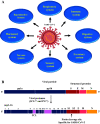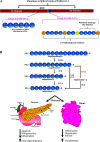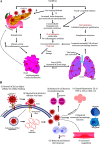Mechanisms of COVID-19 pathogenesis in diabetes
- PMID: 35776683
- PMCID: PMC9359655
- DOI: 10.1152/ajpheart.00204.2022
Mechanisms of COVID-19 pathogenesis in diabetes
Abstract
Coronavirus disease 2019 (COVID-19), caused by the severe acute respiratory syndrome coronavirus 2 (SARS-CoV-2) virus, is a global pandemic impacting 254 million people in 190 countries. Comorbidities, particularly cardiovascular disease, diabetes, and hypertension, increase the risk of infection and poor outcomes. SARS-CoV-2 enters host cells through the angiotensin-converting enzyme-2 receptor, generating inflammation and cytokine storm, often resulting in multiorgan failure. The mechanisms and effects of COVID-19 on patients with high-risk diabetes are not yet completely understood. In this review, we discuss the variety of coronaviruses, structure of SARS-CoV-2, mutations in SARS-CoV-2 spike proteins, receptors associated with viral host entry, and disease progression. Furthermore, we focus on possible mechanisms of SARS-CoV-2 in diabetes, leading to inflammation and heart failure. Finally, we discuss existing therapeutic approaches, unanswered questions, and future directions.
Keywords: ACE2; SARS-CoV-2; cardiovascular; coronaviruses; inflammation.
Conflict of interest statement
No conflicts of interest, financial or otherwise, are declared by the authors.
Figures




References
-
- Rothe C, Schunk M, Sothmann P, Bretzel G, Froeschl G, Wallrauch C, Zimmer T, Thiel V, Janke C, Guggemos W, Seilmaier M, Drosten C, Vollmar P, Zwirglmaier K, Zange S, Wölfel R, Hoelscher M. Transmission of 2019-nCoV infection from an asymptomatic contact in Germany. N Engl J Med 382: 970–971, 2020. doi:10.1056/NEJMc2001468. - DOI - PMC - PubMed
Publication types
MeSH terms
Substances
Grants and funding
LinkOut - more resources
Full Text Sources
Medical
Miscellaneous

